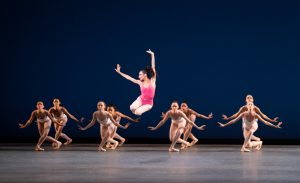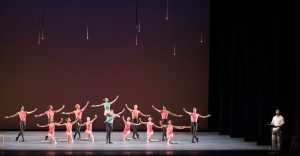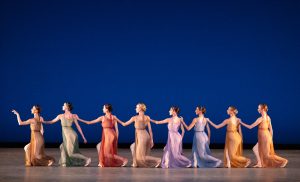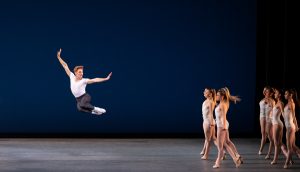
What could be more apropos for Miami City Ballet than to finish off their performance season with a program that highlighted George Balanchine and Jerome Robbins? The strong performance on May 13 at the Kravis Center gave pause for reflection on the different styles of the two iconic choreographers.
As usual, the company’s dancing was in top form in this last program, dubbed Entradas. Whether you interpret Entradas as starter or main course/plate, this last program of the season for me was more of a sobremesa — a beautiful dessert with a savory middle. Large ensemble ballets by Balanchine began and ended the program framing the two smaller, more intimate works by Robbins.
Nearly half of MCB’s 100-plus dances in the repertory are by Balanchine, so the urge to “dust off” a ballet by updating it in some way must be a real temptation. After all, time is passing and many of the works are 75 or so years old. Such was the case with May 13’s version of Balanchine’s Square Dance, a 1957 work that he revised in 1976. This season, with much hoopla about the company connecting with its Latin-Miami roots, Artistic Director Lourdes Lopez “unrevised” Square Dance by bringing back the square dance caller and giving the well-known ballet a Miami makeover.
Although this work is considered one of Balanchine’s Americana ballets, a work that celebrates the spirit of his adopted country, this Square Dance is definitely not square dancing. Set to the Italian Baroque music of Antonio Vivaldi (two concerti grossi) and a badinerie and gigue by Arcangelo Corelli, it is a lively work filled with a multitude of quick ballet-based steps that Balanchine masterfully constructed to capture the high spirit for which square dancing is known.
Taylor Nuturkas, who has been highlighted this season, was a standout in her Allegro bravura, moving impossibly fast while being nicely paired with Alexander Peters; both excelled in their role debuts as the lead couple. Peters also had a chance to show another side to his full and fluid dancing in the slow and contemplative solo that Balanchine added when he revised the ballet.
In this version of Square Dance, I unfortunately wasn’t able to fully focus on the fine ensemble dancing. In the original version, which is performed on a bright stage with the dancers wearing leotards and tights ranging from pale blue to pale gray to pure white, the choreography remains the main focus. In MCB’s tropical version, the subdued lights that reflected a summer evening, together with the warm rose coral tones of the costumes, muted the clarity of the intricate puzzle of steps that Balanchine had devised.

But the biggest distraction — without a doubt — was the reinstated caller (no wonder Balanchine had decided to eliminate him). Too brightly lit and upfront on the side apron of the stage, a very tall man (Philip Kalmanovitch) in white habanera shirt called out to the dancers in a sing-song inflection rather than an instructive tone. The mixture of English and Spanish, phrases like “Spanish lingo adding fun” and “Caballeros, let’s keep dancing” pulled our attention and seemed to have little to do with dancing that was happening too far in the background.
The simplicity of the ballet Afternoon of a Faun was a welcome respite after the distracting Latin overlay on the “reimagined” Square Dance. Robbins’ duet was inspired by Claude Debussy’s 1894 masterpiece of impressionist composition, Prélude à l’après-midi d’un faune, which was in turn inspired by Stéphane Mallarmé’s poem L’après-midi d’un faune. Choreographed in 1953, it featured the beyond-good-looking couple of Dawn Atkins and Stanislav Olshanskyi.
The sheer physical beauty of the dancers moving together was intoxicating even as we realized that they were not looking out at us but were vainly admiring themselves in the rehearsal studio mirror. Olshanskyi, a Ukrainian who recently joined MCB as a principal dancer, has an elegant, smoldering presence onstage and was an effortless partner, as was seen when he caressed the waist-long blond hair of Atkins and she magically soared upwards into a soaring lift as if she had swooned from his touch.

Robbins’ Antique Epigraphs (which was added to MCB’s repertory just last summer) was a quiet and serene work (also set to music by Debussy) that evoked the female figures seen on Hellenic friezes that had somehow come to life. The women, dressed in diaphanous long chiffon tunics, floated around the stage as four broke out into solos only to return to the circle and bond of the other women.
As in Afternoon of a Faun, Robbins utilized the strength of simplicity. His movement was chiseled, as the women who had been immortalized in marble revealed their various characters through their movement. Samantha Hope Galler led the way in a solo that seemed a little ominous. Ashley Knox dressed in pale blue was followed by two cohorts who stayed beside her. Tall Hannah Fischer brought four women with her — reminding us of the five Muses — as she struck flexed arm poses in her pale green chiffon gown. Naturkas caught the quick accents in the music with her concentrated movement and concise energy.
The pièce de résistance was the Symphony in Three Movements, if not simply because of the sheer number of dancers onstage — six soloists, 10 demi soloists and 16 corps members. This ballet is a shining example of Balanchine’s leotard ballets where there is no plot, no scenery, just his signature, fast-paced and complex choreography that brings music to life before our eyes.
The ballet was named after Igor Stravinsky’s compelling Symphony in Three Movements which he had composed during World War II. Balanchine had often worked creatively with his friend and colleague Stravinsky and when the composer died in 1971, Balanchine chose this challenging score for the first ballet to open the 1972 New York City Ballet Stravinsky Festival.
The opening scene was a stark and bold diagonal line of 16 female dancers in white camisole leotards bent over until they began undulating in a canon that had the effect of a lit fuse on a stick of dynamite. In rapid fire, dancers entered and exited with an athletic prance-like run. Nathalia Arja, bold in a dark red leotard, together with Peters, darted through the flanks of dancers in white. The ranks swelled as they were joined by the duo of Knox and Steven Loch as well as five other couples dressed in black and white.
The constant changing of the formations had a regimented feel as if they were executing drills. There was a seriousness in the tone of the dancers’ expressions. Tricia Albertson and Renan Cerdeiro danced a slow and somewhat quirky pas de deux to the second andante movement. There were little accents of subtle humor, such as when Cerdeiro shuffled around Albertson as he promenading her in a flex-footed back attitude as if she were a mechanical doll.

In the final ensemble section, as all 32 dancers were moving with great speed in and out of the complex patterns, one sensed the message how there is power in numbers. The final pose of the ballet was an unusual and memorable tableau. The men crouched low to the ground in a ready position and the women stood in the back with their straight arms in varying positions as if sending a signal.
The flow of the program allowed us to appreciate the long-lasting appeal and craftmanship of these two masters as well as savor their different choreographic styles. The Balanchine pieces were abstract, plotless ballets with minimal costumes while the Robbins ballets had characters and thus more sense of theatricality. Musically, Balanchine had an almost analytical response to the scores while Robbins’ response was more emotional.
The guest conductor who masterfully led the Opus One Orchestra through quite an array of music of the Opus One Orchestra was the diminutive and spritely Tania León, also a highly regarded composer, educator, and adviser to arts organizations. In 2021, the 80-year-old maestro was awarded the Pulitzer Prize in Music for her orchestral work Stride and in 2022, she was recognized with a Kennedy Center Honor, one of the nation’s most prestigious awards for lifetime achievement in the performing arts.
León’s joy of performing with and for the ballet dancers was clear from her luminous smile from the conductor’s podium and from the stage when she took her bow with the company. Her first professional experience after arriving from Cuba in 1967 was with Arthur Mitchell, who asked León to help him establish the Dance Theatre of Harlem.
Principal dancer Albertson also had a special moment onstage during the final bows when it was announced that she would be retiring after 26 years with Miami City Ballet. During her time with the company, she has danced most of the corps, soloist and principal roles in the company’s vast repertoire. Fortunately, she will be staying close as she will be taking on a new role at the ballet as rehearsal director.
Her well-deserved onstage tribute included the dancers, staff and friends individually presenting her with a pink rose. The last to present her with a rose was Lopez, who graciously bowed in a deep curtsy to show her respect for Albertson’s valuable contribution to the company after all these years.